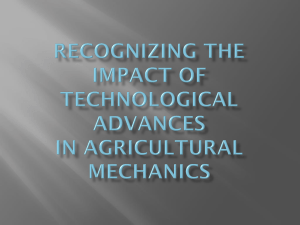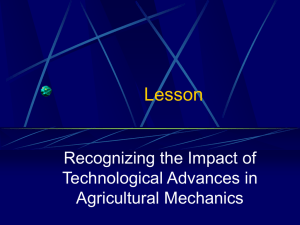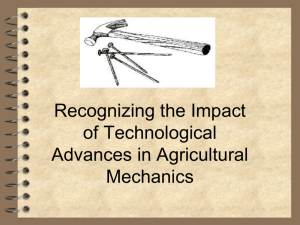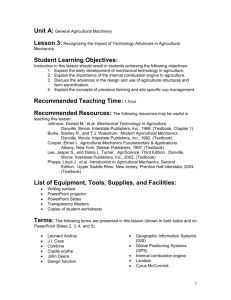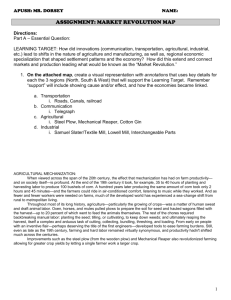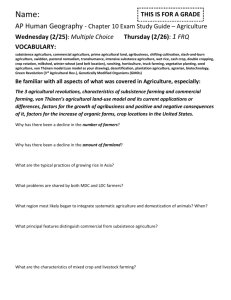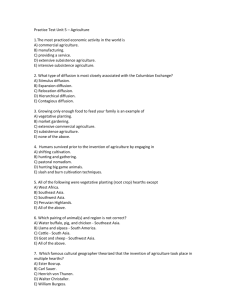Ag. Mechanics Advances
advertisement
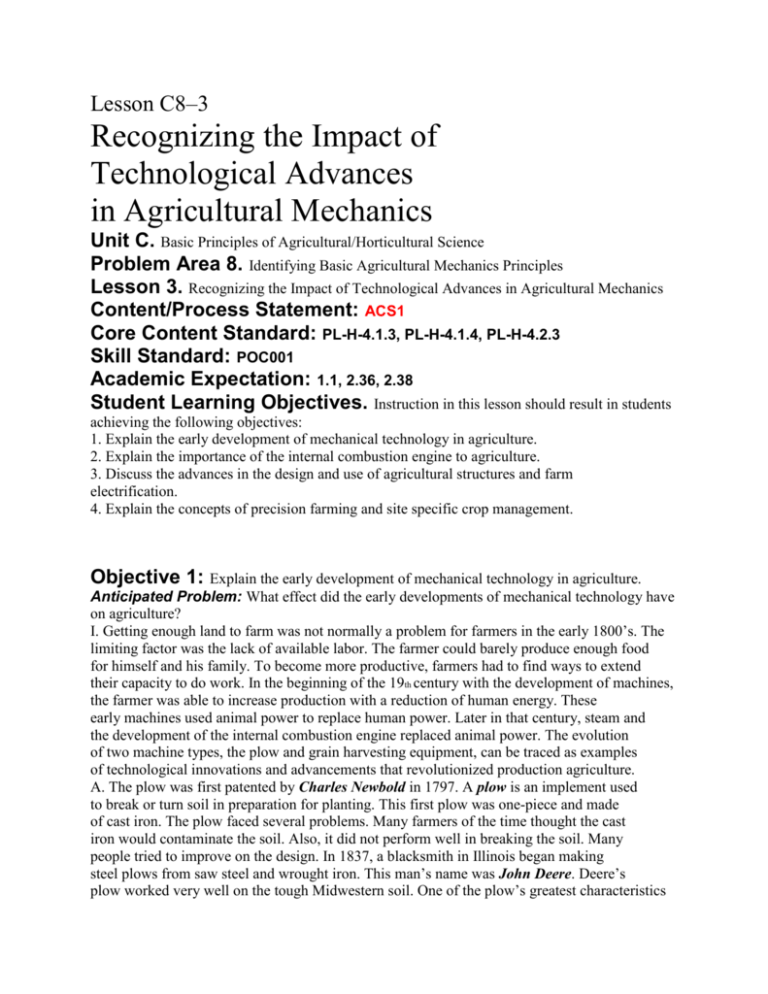
Lesson C8–3 Recognizing the Impact of Technological Advances in Agricultural Mechanics Unit C. Basic Principles of Agricultural/Horticultural Science Problem Area 8. Identifying Basic Agricultural Mechanics Principles Lesson 3. Recognizing the Impact of Technological Advances in Agricultural Mechanics Content/Process Statement: ACS1 Core Content Standard: PL-H-4.1.3, PL-H-4.1.4, PL-H-4.2.3 Skill Standard: POC001 Academic Expectation: 1.1, 2.36, 2.38 Student Learning Objectives. Instruction in this lesson should result in students achieving the following objectives: 1. Explain the early development of mechanical technology in agriculture. 2. Explain the importance of the internal combustion engine to agriculture. 3. Discuss the advances in the design and use of agricultural structures and farm electrification. 4. Explain the concepts of precision farming and site specific crop management. Objective 1: Explain the early development of mechanical technology in agriculture. Anticipated Problem: What effect did the early developments of mechanical technology have on agriculture? I. Getting enough land to farm was not normally a problem for farmers in the early 1800’s. The limiting factor was the lack of available labor. The farmer could barely produce enough food for himself and his family. To become more productive, farmers had to find ways to extend their capacity to do work. In the beginning of the 19th century with the development of machines, the farmer was able to increase production with a reduction of human energy. These early machines used animal power to replace human power. Later in that century, steam and the development of the internal combustion engine replaced animal power. The evolution of two machine types, the plow and grain harvesting equipment, can be traced as examples of technological innovations and advancements that revolutionized production agriculture. A. The plow was first patented by Charles Newbold in 1797. A plow is an implement used to break or turn soil in preparation for planting. This first plow was one-piece and made of cast iron. The plow faced several problems. Many farmers of the time thought the cast iron would contaminate the soil. Also, it did not perform well in breaking the soil. Many people tried to improve on the design. In 1837, a blacksmith in Illinois began making steel plows from saw steel and wrought iron. This man’s name was John Deere. Deere’s plow worked very well on the tough Midwestern soil. One of the plow’s greatest characteristics was that it scoured (self-cleaned) very well. Deere formed a partnership with Leonard Andrus and began producing his steel plows. B. The technological advancements in equipment to harvest grain were much more dramatic than those in the development of the plow. Until the 1800s, the traditional tools for harvesting were the sickle and the cradle scythes. The sickle is a sharp, curved metal Kentucky Agricultural Education Lesson Plan Library — AgriScience Unit C. Problem Area 8. Lesson 3. Page 3. blade fitted with a short handle. While the cradle scythe is a hand-held implement with a long curved blade attached to a long, bent handle. The mechanical reaper was not developed until the 1830s. It was one of the most significant farming inventions of the 19th century. The mechanical reaper was an implement that was used for cutting and gathering a crop. This machine reduced the amount of time and labor needed to harvest by more than one-half. Cyrus McCormick patented the first horse-drawn reaper. In the 1850s, J.I. Case began to manufacture and sell a “combine” – combination thresher-separatorwinnower – that threshed the grain, separated it from the straw, and removed that chaff. Again, this machine greatly reduced the time and labor needed as well as crops lost during harvest. There are many techniques that can be used to assist students in mastering this material. Students need text material to aid in understanding the effects the early developments of mechanical technology had on agriculture. Chapter 1 of Mechanical Technology in Agriculture is recommended. Use TM: C8– 3A and TM: C8–3B to aid in student discussion. Objective 2: Explain the importance of the internal combustion engine to agriculture. Anticipated Problem: How has the internal combustion engine been important to agriculture? II. In the late 19th century, a tractor powered by an internal combustion engine was developed. An internal combustion engine converts the chemical energy from fuel into heat energy, which is converted into mechanical power. The first tractors were simply an engine bolted to a wheeled, steel frame. The tractor quickly became the preferred power source of the farmer. Tractors, trucks, and self-propelled machinery powered by the internal combustion engine revolutionized American agriculture. Almost all aspects of today’s agricultural production utilize the internal combustion engine in some way. The main reason for the success of the internal combustion engine was that it provided a reliable, efficient and mobile source of power. There are many techniques that can be used to assist students in mastering this material. Students need text material to aid in the understanding of the effect the internal combustion engine had on agriculture. Have students compile a pictorial history of the improvements in tractors from the late 19th century to today. Chapter 1 of Mechanical Technology in Agriculture is recommended. Use TM: C8–3C to aid in the discussion. Kentucky Agricultural Education Lesson Plan Library — AgriScience Unit C. Problem Area 8. Lesson 3. Page 4. Objective 3: Discuss the advances in the design and use of agricultural structures and farm electrification. Anticipated Problem: What are some of the advances in the design and use of agricultural structures and farm electrification? III. Early farm structures were constructed for only one purpose. They were made to shelter livestock and equipment. The only building materials were those available locally. Structures were all of similar design. There was also no way for the farmer to control the internal environment of the structure. Today’s modern structures differ in many ways. A. Modern structures have become specialized. Very seldom are general-purpose structures built. When designing a structure, the producer first determines what the design function of the building will be. A design function is the purpose for which a structure has been created. Internal environments can now be controlled. This gives the producer added control over the quality of the goods and products he/she sells. B. Electricity has had an impact on agriculture equal to or greater than that of the internal combustion engine. Electric power has replaced much of the hand labor required. Although electricity has been a relatively recent addition to agriculture, the expansion of electrical technologies has been quite rapid. There are many techniques that can be used to assist students in mastering this material. Students need text material to aid in the understanding of this material. Chapter 1 of Mechanical Technology in Agriculture is recommended. Objective 4: Explain the concepts of precision farming and site specific crop management. Anticipated Problem: What is precision farming and site specific crop management? IV. Site Specific Crop Management (SSCM) involves using technology to apply the correct amount of appropriate inputs to crops, to apply that amount to a specific field location, and to apply inputs to cost-effectively produce a crop. The many advances in agricultural mechanics have allowed such operations to occur. There are many separate components that all work together to allow a producer to use SSCM. They are: A. Precision Farming – Precision farming is using cropping practices that improve yield based on the needs of the land. As part of this system, fields are subdivided into small areas based on the information gathered by harvest results, soil testing, and satellite systems. This information is then used to determine the kinds and amount of inputs to be applied to the subdivisions of land. The goal of precision farming is to apply seed, fertilizer, and agricultural chemicals only where they are needed and only in the amounts needed. It has been said that precision farming is farming by the foot rather than by the field. B. Remote Sensing – Remote sensing involves gathering and recording data from a great distance. Most remote sensors are on satellites some 500 miles above the earth. Landsat Kentucky Agricultural Education Lesson Plan Library — AgriScience Unit C. Problem Area 8. Lesson 3. Page 5. is the term used to describe the United States satellite system that makes photographs of the earth and plots the earth’s resources. These photos are used to make maps. Remote sensing is beneficial in forecasting the weather, locating natural resources, detecting crop disease, and protecting the environment. C. Geographic Information Systems (GIS) – The Geographic Information System (GIS) partitions fields into grids and then maps them for physical attributes per grid segment. Individual maps can be made for fertility, pesticide residues, soil type and texture, drainability and water holding capacity, and the previous year’s yield data. These maps are then used by the producer to make management decisions regarding application rates of fertilizers and other agricultural inputs. The satellite system used to gather this information is called the Global Positioning System (GPS). GPS was first developed as a defense system. The basic concept behind it is satellite ranging or triangulation. Positions on the earth are determined by measuring the distance from a group of satellites in space. D. Variable Rate Technology (VRT) – Using the information gathered with the Geographic Information Systems, the producer is able to vary the rate of application of all production inputs. This capability is called Variable Rate Technology. VRT allows for the rate of these inputs to be varied as the application equipment is traveling across the field. The ability to do this is key to gaining the full benefits of site specific crop management systems.
